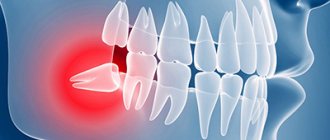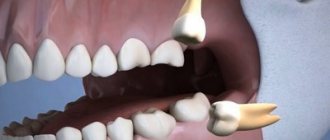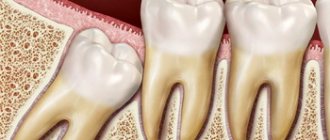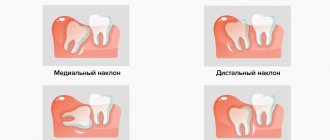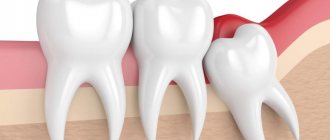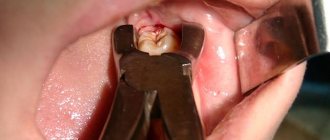Wisdom teeth (third molars, “eights”) are rightfully considered the most problematic teeth. For a rare lucky person, their eruption proceeds safely. After all, even if the number eight has enough space in the dentition - which is rather an exception in modern realities - while passing through the gums, this large multi-tubercular tooth causes a lot of suffering to its owner. That is why in America, for example, wisdom teeth are removed prophylactically, before eruption - even during their formation.
What problems can arise from wisdom teeth?
Wisdom tooth hurts: what to do?
There are two most common scenarios:
- my wisdom tooth is cutting out, my gums hurt because of the inflamed hood.
This happens if eruption is carried out by tubercles (in other words, the chewing part is already visible, and the remaining part is located inside the gums, being covered with mucous membrane). The mucous membrane, which seems to hang over the crown, is called the hood. This is an ideal place for the proliferation of bacteria that provoke the inflammatory process.
If the inflammation is minor and there is no discharge of pus, then you can cope on your own: rinsing with a solution of Chlorhexidine at a concentration of 0.05%, as well as applying Cholisal-gel or its analogues, help. The procedure is as follows: the mouth is thoroughly rinsed for one minute with Chlorhexidine, then the surface of the gums is dried with tampons and the gel is applied with a finger, after which it is recommended not to eat food for at least a couple of hours. The procedure should be carried out twice a day (after breakfast and at night).
To understand that the inflammation is severe (this can be determined by pus discharge, severe swelling and painful sensations during swallowing), then you cannot do without the help of a doctor. Few people like visiting the dentist, so often a person tries to reduce inflammation by rinsing with various solutions: if the effect of such measures is at all, it will be insignificant and short-lived. Therefore, it is better not to waste time, but to immediately go to the hospital, where the dentist will excise the hood - this is a relatively simple 5-minute operation, but the stronger the inflammation, the more difficult it will be to tolerate.
- small amount of space required for eruption.
Often a wisdom tooth grows and hurts due to insufficient free space. Then the tooth begins to put pressure on the adjacent tooth, trying to make space for itself. Gradually, displacement occurs, causing a feeling of pain.
This situation is fraught with crowding of teeth. It is for this purpose that wisdom teeth are removed, which helps prevent crowding, which leads to the installation of braces in the future.
Causes of abnormal growth
“Eights” or, as dentists call them, third molars, are a vestige left over from our ancient ancestors - the Neanderthals. The structure of their skull was different, and their jaw was more elongated, so there was enough room for 16 teeth. Over time, the structure of the head changed, human food became softer, and the jaws stopped protruding strongly forward - the “eights” simply became cramped. Sometimes they literally have nowhere to grow, so they erupt wherever there is at least a little free space. There are frequent cases when a dystopic wisdom tooth begins to grow towards the cheek in both the upper and lower jaws) - you can understand what kind of anomaly this is from the visual photo below.
The pathological process of eruption also arises because the “eights” do not have milk precursors, and therefore, no ready place for growth and location, like the other units of the series. Therefore, they have to pave the way with difficulty, in several stages. For the same reason, in some people, third molars do not grow at all - they either remain in the thickness of the bone or do not form at all.
For your information! In some European and American clinics, doctors remove third molars at the stage of their formation, thus saving patients from the painful periods of eruption of “eights” and possible complications with their growth. Russian dentists do not adhere to this practice, believing that there is no point in removing a healthy “eight”: sometimes when other molars fail, it can become a support for an orthopedic bridge during prosthetics.
Sometimes the cause of a dystopic “eight” can be a pathology of the jaw structure (as a rule, such a defect is inherited) or a non-standard shape of the third molar (too large a crown). You can see in detail what a wisdom tooth looks like growing into the cheek in the photo.
Wisdom tooth pain: caries, periodontitis, pulpitis
Pain can be associated with various diseases. In each specific case, a decision on treatment or removal must be made individually.
- Wisdom tooth: symptoms of caries . You can guess the presence of a carious formation by the reaction to irritants (sweet or sour foods, exposure to temperature). The pain stops when the stimulus stops. Is it worth treating or is it better to remove the tooth? The dentist and patient will have to decide this together. Much depends on the position of the tooth, the need for further prosthetics and other reasons. Expensive treatment is not always justified, especially if you take into account the limited functional significance of a given tooth.
- Pulpitis . With this disease, the pain is acute and paroxysmal, occurring without any reason. At night it can get worse many times over. When pulpitis enters the chronic stage, the pain becomes aching and its intensity decreases.
- Periodontitis . It is distinguished by aching pain sensations, clearly identified specifically in the wisdom tooth. When biting, the pain becomes stronger. The gums and cheek may swell in the projection of the affected tooth. Chronic periodontitis can be asymptomatic, and a fistula with purulent contents is likely to occur.
Possible complications after removal - and their differences from the norm
Three conditions are considered normal after surgery: pain, swelling and bleeding. Let us consider the characteristics of normal and pathological conditions in detail.
Pain in the intervention area
Painful sensations may persist for 2-3 days, and to get rid of them, you can take NSAIDs (Ibuprofen, for example) or any painkiller. If the pain intensifies or is poorly suppressed by analgesics, you should consult a doctor.
“When I first heard the name of the film “The Hateful Eight,” I thought that it was just about my long-suffering eight))) But, of course, I was the sufferer here. The eruption lasted for years, and the surgeon probably periodically opened the gum cap four times, until I decided that that’s enough, I’m waiting for Monday and going to ask for removal. They took an x-ray and scheduled surgery in 2 days. And, no matter how afraid I was, everything went perfectly - the injection froze the jaw longer than the removal itself lasted. I had to take sick leave, though, because on the first evening it felt as if a truck had driven into my jaw. But gradually everything returned to normal, the main thing is to listen carefully to what the doctor advises while the wound heals.”
Valentina88, review from otzovik.com
The appearance of swelling and hematoma on the cheek
Swelling can also last for two days. As a rule, it subsides as soon as blood circulation in the injured area improves. If the swelling increases, the temperature rises, or other signs of inflammation appear, then you need to urgently go to the dental clinic. A hematoma (or bruise) on the cheek appears on the 2nd day after complex removal and can persist for up to 7-14 days, gradually turning pale.
Bleeding from the wound
Bleeding after removal is a natural protective reaction of the body. As a rule, within 2-3 hours after surgery, a blood clot forms and closes the socket. After this, the bleeding either stops altogether or remains in the form of so-called ichor for several more hours. If light bleeding continues a day later or within 3-4 hours after removal heavy bleeding persists, then this is a reason to seek medical help.
What does the appearance of pus and temperature indicate?
If purulent discharge appears around the hole, if the body temperature rises to 38 degrees, pain from the removal site begins to spread to the eye, ear, neck, nose, signs of intoxication appear (headache and muscle pain, weakness, dizziness, etc.) These are signs of a developing complication. A quick visit to the dentist will avoid their negative consequences.
Wisdom tooth coming out: problems
If a wisdom tooth is cut, the process is often accompanied by the following troubles:
- An inflammatory process that causes pain . The strength of the pain depends on the availability of free space and the severity of inflammation, accompanied by an increase in temperature, swelling of the cheek, and the appearance of bad breath.
- Destruction of the seventh tooth . When a wisdom tooth grows at an angle, resting against the seventh tooth, the pressure exerted on it can lead to the destruction of the enamel and the formation of caries. To save the 7th tooth, the wisdom tooth will have to be removed.
- Cheek growth . This is a very common complication. A tooth that erupts almost horizontally cannot fully participate in chewing food, causing a lot of problems for a person (it will periodically become inflamed, there is a high probability of biting the tongue or cheek). If a tooth cuts your cheek, you should not let the situation develop by itself, since constant contact with the mucous membrane can cause the development of an ulcer and even the formation of a tumor.
How to determine?
There are several signs by which you can immediately understand that a tooth is growing in the wrong direction. This is evidenced by:
- Pain at the end of the dentition.
- Pain and bleeding from mechanical stress, such as brushing teeth or chewing hard food.
- Swelling and hyperemia of the soft tissues near the inside of the cheek.
- Most often, the teething process is delayed for several months or even several years.
- It is visually noticeable that the apex of the tooth is located abnormally.
Should I treat or remove my wisdom tooth?
It is better to remove a tooth if:
- he is in the wrong position. It is not involved in chewing, so if it causes inconvenience and pain, it is more advisable to remove it;
- there is no room for normal teething. A small amount of free space can cause crowding and misalignment of teeth;
- destruction of the tooth in front. If a wisdom tooth is cut incorrectly, it often puts pressure on the tooth next to it, destroying its enamel;
- destruction of the crown. A crown severely damaged by caries is quite difficult, if not impossible, to restore.
You should try to save a tooth if:
- there are no teeth in front, or they are planned to be removed soon;
- the tooth takes an active part in chewing, takes the correct place in its row;
- It is possible to fill canals for pulpitis.
Symptoms of the problem
The reasons for the incorrect eruption of third molars are the lack of ready-made conductive canals, since there are no milk analogues. However, formation begins as early as five years of age, causing discomfort and pain.
Malposition and pain during growth are usually caused by the following reasons:
- jaw abnormalities, including hereditary ones;
- the position of the molars is incorrect;
- there is an excessive number of ones in the row, there is not enough space for eights;
- the shape and size of the molars are non-standard;
- hormonal disorders of the patient, metabolic problems;
- early removal of a tooth, the appearance of large gaps.
In the normal position of the teeth and jaw, eruption occurs almost imperceptibly, there is no pain or inflammation, and the figure eights take their position. But with a narrow jaw, severe pain and swelling appears, the tooth begins to grow sideways, growing into the surrounding oral tissues. This is accompanied by the following symptoms:
- bleeding, pain also occurs when brushing or flossing;
- discomfort during chewing loads;
- mucosal tissues are swollen, discoloration is observed;
- the inner surface of the cheek is injured, it is constantly bitten, and swelling appears when ingrown;
- swelling and signs of inflammatory processes appear in the gums and tongue;
- headaches, fever appear, and the condition worsens.
In especially severe cases, eruption lasts for several years, during which the patient constantly feels pain and discomfort. This requires contacting a doctor, who, after examination, chooses a treatment method.
Prevention
Taking care of your oral health in a timely manner is much easier, cheaper and painless than treating a chipped tooth. A few simple tips will help make your teeth strong and prevent chips and fractures:
- Care for your mouth regularly, use rinses and dental floss after meals. It wouldn't hurt to have your teeth professionally cleaned.
- Do not overeat too hot or cold food and, especially, do not mix them.
- Get rid of bad habits - biting nails, pencils, biting threads.
- Eat well, include calcium, magnesium and vitamins in your diet.
- Limit your intake of sweet and sour foods.
- Visit your dentist 1-2 times a year to replace old fillings, put in new ones, get rid of tartar and get advice.
If a tooth breaks or chips, do not put off going to the dentist. The defect may be more serious than it seems at first glance. Some fractures, for example those with a crack at the root, should never be ignored. Only a specialist can assess the real extent of the damage.
Don't forget that disease is easier to prevent than to cure. Take care and strengthen your teeth - the stronger they are, the less susceptible they are to chips and fractures.
Treatment
Lesions of the lining of the oral cavity cannot be ignored. Treatment primarily involves eliminating provoking factors and bad habits. Injury to the cheek by teeth requires disinfectants, anti-inflammatory drugs, and bactericidal therapy. It is important to relieve irritation, reduce pain, burning, and remove swelling. Traumatic lesions are treated according to the following scheme:
- First, all habits and factors that cause harm to the mucous membrane are eliminated.
- Then applications with painkillers (anesthetics) are applied to the defective areas. These can be suspensions, Kalgel, Pansoral.
- Applications may contain proteolytic enzymes such as trypsin, lysozyme, chymotrypsin.
- The affected areas are treated with weak solutions of antiseptic drugs such as Corsodil, Stomatofit. The latter remedy is multicomponent. It relieves inflammation, has an antiseptic effect, and heals wounds.
- According to indications, a prosthesis is placed on the destroyed organ. Veneers are often used for one tooth.
- Prescribed preparations for rinsing the mouth.
- Products that stimulate regeneration are recommended. These include Kamistad, Solcoseryl, Vitaon.
Gels for external use may contain tincture of medicinal herbs, lidocaine hydrochloride, and other medical substances. Lidocaine and its analogues help to quickly eliminate pain. The gel base allows you to distribute the product throughout the affected membrane, rubbing it in with massaging movements. Therapy of the affected areas is carried out with adhesive preparations that remain on the mucous membrane for a long time. Long-term adhesion is ensured by components such as pectin, gelatin and pectin.
Dentists prescribe drugs that improve the oxygen supply to affected tissues, restore defective areas, accelerate the healing period, and have excellent binding ability. After applying modern ointments, not only does the pain disappear, the product adheres well to defective tissues, forming a protective layer on them that protects them from chemical and mechanical damage. This is a protective layer from the effects of aggressive saliva, as well as food. The anhydrous base of medicinal pastes absorbs wound discharge. In the treatment of pathologies, it is important to use drugs from several pharmacotherapeutic groups that quickly relieve clinical symptoms and ensure epithelization of the lesion.
Incorrectly restored tooth
- Poor performance of the filling , violation of technology and methodology during restoration (we will not dwell on this).
- The type of restoration is inadequately selected, in a word, “too big a filling” (i.e. they put a filling in cases where it can no longer be placed, but there are all the indications for “more serious” ceramic restorations (inlays, crowns).
I would like to dwell on the second reason in more detail.
Competent dentists know that there is an index of tooth surface destruction (DSI), which must be taken into account before restoring teeth in order to do it correctly. For you, dear patient, I will describe it in a simplified way. If the tooth is not severely damaged (conditionally up to 40% of the surface), a filling is an excellent way to restore it. Destruction of 40 to 70% of the surface requires the manufacture of a ceramic inlay or strengthening of the tooth with various pin structures.
If there is a significant degree of destruction of the tooth surface (more than 70%), the tooth should be correctly restored with a crown. In a word, the type of tooth restoration depends on the degree of destruction.
What's wrong with a filling?
Each recovery method has its own indications. So, a filling is necessary and can be placed in cases of small and medium degrees of tooth decay. If the decay is significant, a large filling can split the tooth in half.
Let's find out why!
Any material (even metal) expands when heated (remember the temperature of the tea you drink!). Temperature changes are a fairly common occurrence that our teeth encounter (from hot tea to ice cream). The coefficient of thermal expansion of filling materials is still higher than that of tooth tissue. That is, when hot food is consumed, the filling expands more than the tooth tissue that surrounds it. The larger the volume of the filling, the greater the expansion (this is why a large volume of the filling is so undesirable).
Of course, this expansion is minimal, not noticeable to any eye and not perceptible. However, add to it a chewing load (which far exceeds temperature deformations), a large filling, thinned tooth tissue, and the likelihood of chipping increases many times over.
Unlike filling materials, ceramics (from which crowns and inlays are made) have a closer coefficient of thermal expansion to the tooth tissues, and therefore do not contribute to its chipping. In addition, it is stronger. That is why it is correct to restore severely damaged teeth not with fillings, but with ceramic restorations. There are other physical phenomena that affect the change in the size of the filling and, as a result, the splitting of the tooth.
All of the above, of course, is true only with an adequately completed restoration (even fillings, even crowns). An inaccurate hand of a master can lead to chipping even with ceramic restorations, and on the contrary, a skillful hand can place a large filling so that it will last a long time. However, there is a limit to everything and it is better not to go beyond the indications for restorations if you want to get guaranteed and reliable work.
Conclusion : you should not expand the indications for conventional fillings too much; they are not capable of qualitatively restoring a badly damaged tooth. But in case of minor tooth decay, fillings have proven themselves to be excellent!
Let me give you a photographic example.
The patient complained that it was painful for her to bite on one of her teeth, that something “crunched” in it.
Upon examination, we determined: tooth 4 on the upper jaw: it has a medium-sized filling (at first glance). And a movable, broken tooth wall, which is held together only by the gums. This wall is no longer attached to the tooth.
The broken fragment of the tooth is mobile, easily moved to the side, but has not yet been removed.
View of the tooth after removing the broken wall: the cheek wall was chipped under the gum. A large filling and a thin remaining tooth wall on the palatal side are visible. Some doctors may try to restore such a tooth using a crown (with preliminary extension); some doctors will offer a perhaps more predictable option: removal and subsequent implantation.
Why are teeth restored incorrectly?
It’s absurd, but often the dentist follows the patient’s lead. The patient, not fully understanding all the subtleties and features of the distribution of the load when chewing, refuses the inlay or crown and asks the doctor to “put a filling”, they say, I’ll work with it a little more, and only then the crown! As a result, at the most inopportune moment, a “piece” of the tooth breaks off. As a result, such “pity” of the doctor for the patient turns out to be a bigger problem for the patient than timely adequate tooth restoration.
By clicking on the “Make an appointment” button, I consent to the processing of my personal data.
I have read and agree with the conditions for processing personal data set out on the website ds-chocolate.ru.
Consent to the processing of personal data
How to properly restore teeth?
When treating a tooth, the doctor must remove all carious tissues, old fillings, movable walls, if any, completely clean the tooth and only then assess the degree of destruction (which walls and cusps have survived, whether they are able to bear the load, how the load on this tooth will be distributed during different methods of restoration, whether chips of any wall are possible, whether its restoration will lead to a split of the root, etc.). After such an assessment, it is determined how to properly restore the tooth: is it possible to put a filling, or does it need to be “strengthened with a pin,” or would it be more correct to use a ceramic inlay or a crown.
Conclusion: a properly selected restoration will preserve the tooth for many years, protect it from further destruction, and the patient from having to redo the work in a few years.
